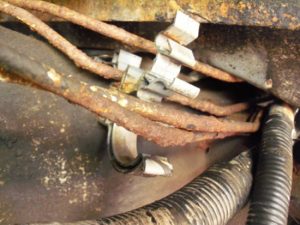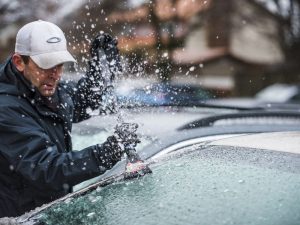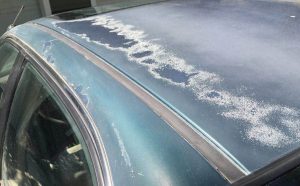Regular maintenance is important. Driving habits are important. But the most important thing – if you want your car to last a long time – is keeping it garaged when you’re not driving it.
Why?
First of all, because it’s dry in there – as opposed to wet, outside. All cars get wet sometimes – unless you never drive them when it rains. But cars parked outside stay wet, even after the rain ends.
This causes them to rust, faster.
You may not see where the rust is forming – but rest assured it is. Especially where you can’t easily see. Brake and fuel lines, nuts and bolts underside. Most of these bits and pieces are regular steel (not stainless) and only superficially protected.
These bits and pieces can add up to big hassles – and bills – once the rust has developed beyond the superficial. If you’ve ever had to deal with rusted out brake/fuel lines, you already know all about it. If you’ve had to pay to get a dealer to replace them, you’ll know even more about it.
A car parked outside is certain to be wet more often – and stay wet for longer. It will inevitably rust faster and sooner and worse.
Parking indoors keeps it dryer – and gives it a chance to dry off. This will hold off rust longer.
Condensation – dew – does not usually form indoors. It forms regularly, outdoors. A car parked outside will thus get wet practically every day – even when it hasn’t rained for days. Including under the hood, where – in a modern car – there are lots of electronic bits and pieces that don’t like moisture. They are insulated, of course. But the insulation is generally made of rubber and plastic . . . which ages faster in the weather.
Which is more temperate inside than out. The extremes of heat and cold are moderated by shelter.
It may not be toasty warm inside an unheated garage during the winter months, but it is probably not as cold as it is outside, during the winter months. There is no wind, for one. And for two, even an unheated garage mooches some heat off the house it’s attached to. If it’s 70 inside, it’s probably at least 40 in the garage – as opposed to 20, outside.
Where would you rather sleep in January?
Cold can be just as hard on a car as it is on you. Remember how your skin dries up and cracks when exposed to bitter cold?
How there is . . . shrinkage?
The same basic thing happens to synthetic skin – rubber and plastic – when exposed to bitter cold. But unlike chapped skin, cracks in the dash don’t heal when it warms up. Cracked weatherstrip doesn’t seal, either – and now the car is vulnerable to getting wet, inside.
Nothing says old car like the smell of musty, moldy carpet.
Very cold weather is also very hard on paint, due to expansion and contraction – which also leads to cracks – and that can mean even more rust, if water gets at the unprotected metal underneath.
Chipping away at accumulated ice can also cause damage (ask the people who sailed on Titanic about the abrasive properties of frozen water).
Hail can total your car.
If it’s parked outside.
Hail may not be a worry when it’s warm – but biological hail is a constant threat when a car is left outside. Bird poop is even more abrasive than ice and caustic. Wind – and the dust carried by it – aren’t good for your car’s finish, either.
It’s not just the cold – or the wet – that constitute threats.
High heat – and direct sunlight – are the accelerated wear yin to the accelerated wear yang of extreme cold (and soggy wet). Long-term exposure to high heat dries out rubber/plastic faster; the flexibility is lost – and the cracks begin. Your car’s interior will look shabbier, sooner. The finish will also fade, faster – and once it does, it can’t be buffed back to shiny – if it’s a modern clear-coat finish. No matter how hard you rub, it will still look dull – because the thing that gave it is shine (the translucent clear coat) has been burned away by the scorching rays of the sun.
The only fix – once it gets to that point – is to repaint the car.
The effects of both are largely eliminated by parking indoors.
You’ll also be able to keep your car looking good with less work. A wax job lasts longer – and it’s easier to clean a car that isn’t as as dirty.
A twenty-year-old car that’s parked inside may still look like a five-year-old car. But a five-year-old car parked outside is very likely to look older than its years.
You may not especially care how it looks but you probably care about what it’s worth. A car that looks good is almost always worth more than a car that doesn’t. It’s also likely to last longer – and given the price of cars, whether new or used – that’s arguably well worth whatever it costs to find a way to keep the one you’ve got parked indoors.
. . .
Got a question about cars, Libertarian politics – or anything else? Click on the “ask Eric” link and send ’em in! Or email me at [email protected] if the @!** “ask Eric” button doesn’t work!
If you like what you’ve found here please consider supporting EPautos.
We depend on you to keep the wheels turning!
Our donate button is here.
If you prefer not to use PayPal, our mailing address is:
EPautos
721 Hummingbird Lane SE
Copper Hill, VA 24079
PS: Get an EPautos magnet or sticker or coaster in return for a $20 or more one-time donation or a $10 or more monthly recurring donation. (Please be sure to tell us you want a magnet or sticker or coaster – and also, provide an address, so we know where to mail the thing!)
My eBook about car buying (new and used) is also available for your favorite price – free! Click here. If that fails, email me at [email protected] and I will send you a copy directly!













Eric,
What are your thoughts on car covers if the car must be stored outside for long periods, esp in the winter? Any particular brands/materials you would recommend? Black? White? Doesn’t matter?
Hi Anon,
I’m ambivalent. Covers can protect against sun damage but (in my experience) seem to always trap moisture. It’s definitely important to get one that fits your specific car and that breathes well. Be aware that they get dirty, regardless – and then you need to clean it.
Eric,
What about when we want to check and adjust our tire pressures, particularly during cold weather? At times, I’ve left my car out the night before I do this, so the pressure’s cold and accurate; my garage is 20-30 degrees warmer than the outside air temp, so that would skew any reading I take right after I pull out of the garage. How much time should I then give my car before checking air pressures? Is an hour enough to get a good reading? Thanks!
I have heard that parking a car that was driven in rain or snow in an unheated garage is actually bad. The under carriage can not dry out due to lack of air flow in the closed garage. It would be better in my opinion to park under a car port permitting air to dry out the under carriage. Again a heated garage is the best option.
Any thoughts about what to do if you do not have a garage?
Are any portable shelters worth the effort and/or expense?
While you may be able to get the vehicle out of the sun and rain,
it will still be exposed to the temperatures and condensation.
Thanks for your thoughts.
For cold conditions, if near a power outlet, an engine block heater is a great option to have.
On my friends portable shelter the cover material seemed to start failing after just a couple years but they will keep the rain and sun off of your car. If not secured they can blow over. If you want your car to last consider getting it rust proofed. Washing it more often will cut down paint and glass damage when you scrape off the frost and brush the snow off.
If storing for longer periods a few more things are needed. Battery kept on a float charger (on newer vehicles check with your mechanic to see if removing the battery will effect the cars settings), fluids changed. washed, a tarp under the car, tires inflated to a higher pressure, mouse traps in around car.
Roger that on the mouse traps. My truck was out of action for a few months, ended up towed to a rural place for repair, came back with a mouse family. Multiple cleanings and treatments with Ozium needed.